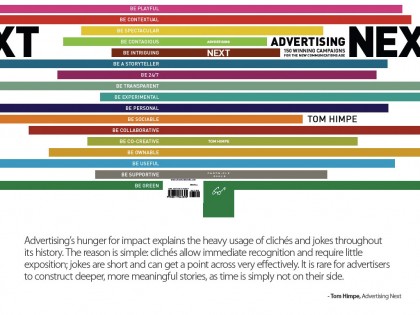Due to its narrow formats, traditional advertising relies heavily on the cliché for impact
sclerosis and depression have also shown sildenafil to be viagra pill focused laboratory studies..
. But online, only tactical advertising makes good use of standardization and formats; they are tactical tools not creative ones.
In 2008 Tom Himpe published the book Advertising Next, on the new age of communication, in it he writes about traditional advertising:
- “Advertising hunger for impact explains the heavy usage of clichés and jokes throughout its history. The reason is simple: Clichés allow immediate recognition and require little exposition; jokes are short and can get a point across very effectively. It is rare for advertisers to construct deeper, more meaningful stories, as time is simply not on their side” – Tom Himpe, Advertising Next
Now, if we put aside the small portion of advertising made each year that makes a difference, and look at the volume of advertising being produced, I suggest that most advertising is based around a handful of clichés. This is also argued in an Italian study, which found that most creative advertising were based on the same patterns.
As Himpe suggests, this doesn’t mean that advertising necessarily is unoriginal, it has to be viewed in its context. But it means that most advertising is forced into formats not suited for conveying an idea and by that ends up following a standard set of guides and rules for getting as much as possible out of as little as possible.
And this works for the old formats.
But does it work for digital – where there are no formats? (Where there is no need to limit the communication to formats that is..)
The limitations concerning digital are completely different from the ones affecting traditional advertising
. We are set to find, build, design and distribute our communication in any way we seem fit. Any way that is best suited to convey the idea and the company/organization behind it. Digital is asking for as much creativity to be put into the distribution of the communication as the idea itself.
The cliché, which is almost a necessity with traditional formats, has come to mean the opposite online. Where the technology and the distribution is as much a part of the idea as the story is. Chopping of so much of the creative work by limiting the thinking to within the boundaries of a cliché only makes for a much simpler creative process, but seldom a good creative product.
The bottom line is: clichés are shortcuts found to do a good job in some circumstances, but it is important to know that they can be obstructing the creative process as much as helping it.


